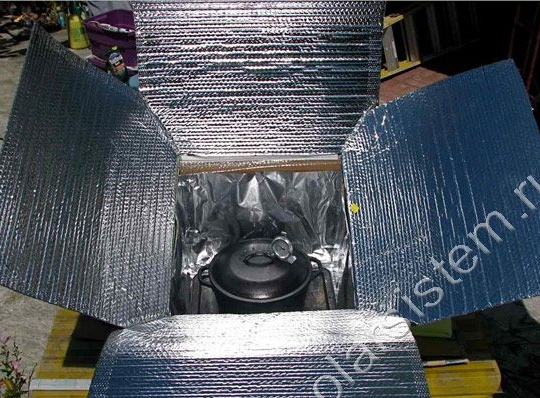
Probably many are very skeptical about the possibility of cooking in a solar oven. For most people, the very possibility of cooking using solar energy does not fit in my head. The easiest way to verify the reality of this idea is to make a solar furnace yourself. That is exactly what the author decided to do.
Materials and tools that the author needed to build a simplified model of a solar furnace:
1) glass
2) cardboard box
3) foil
4) adhesive tape
5) scissors
6) corrugated cardboard sheets
7) black heat resistant paint
8) pan
Let us consider in more detail the design of this model of a solar furnace and the stages of its assembly.
After browsing a large number of sites on the use of solar energy, he read several interesting articles about the construction of solar furnaces from improvised materials. For the first experiment, the author decided to make the furnace as lightweight as possible, the assembly of which requires only a few free hours.
Below you can see a diagram of a cardboard box based solar furnace:
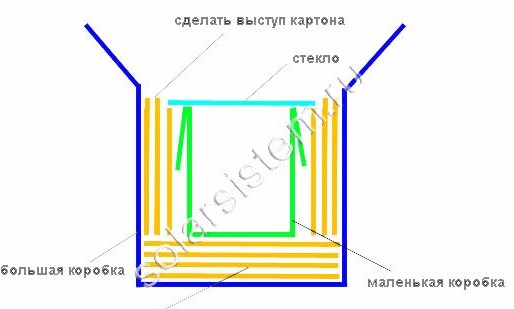
Finding the right one model solar furnace, the author began to assemble it. To begin with, a small cardboard box was selected in which the pan could fit. Moreover, it is advisable to take a pan of black color, since black color best absorbs solar energy. Or you can paint the pan yourself using heat-resistant black paint.
The scheme of the solar furnace, which the author decided to collect using improvised materials:
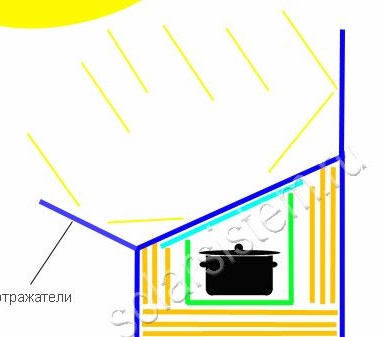
After a suitable small box has been found, it is necessary to find and take another larger box. You need to choose from the calculation so that between the walls of the boxes there is a gap of 30-50 mm. In principle, you can even take two identical boxes and “enlarge” one first with scissors and then fastened with ordinary scotch tape.
Then one side of the box must be cut at a slight angle of 25-30 degrees. This will allow direct sunlight to enter the box even when the sun is low above the horizon, and therefore will increase the possible time of using the solar furnace per day.
After that, the author pasted the inner surface of a small box with reflective foil. Thus, the rays falling into it will be reflected from the walls of the box to fall on the pan, thereby heating it. Also, in order to maintain heat inside the small box where the pot is located, the author decided to cover it with glass. Then, in order to further insulate the inner chamber of the solar furnace, the author decided to fill the gap between the small and large boxes with sheets of corrugated cardboard and mineral wool.
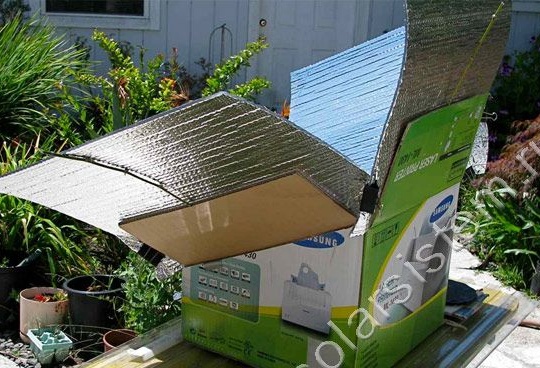
The next step, the author decided to further increase the efficiency of the solar furnace. To do this, a reflective foil coating was also applied to the lid of the box. In the future, you will be able to further improve the design by placing mirror reflectors on the sides of the box, in order to focus even more sunlight on the central box, which serves as a camera for cooking.
The larger the area of the reflectors, the more sunlight heats the pan with food, therefore, the faster it cooks. If you decide to make additional reflectors, then take care of the necessary mounts for them and the possibility of adjusting the location of the sun. It is best to place reflectors at such an angle so that most of the sunlight is directed directly at the pan.


Since this was a trial version of the solar furnace, the author did not particularly pursue improvement, and hence the complexity of the design. However, even such a furnace with weak reflectivity, since ordinary foil was used, and a heater from corrugated cardboard sheets with a high heat transfer coefficient can produce a temperature of about 130 degrees, which is quite enough for cooking.
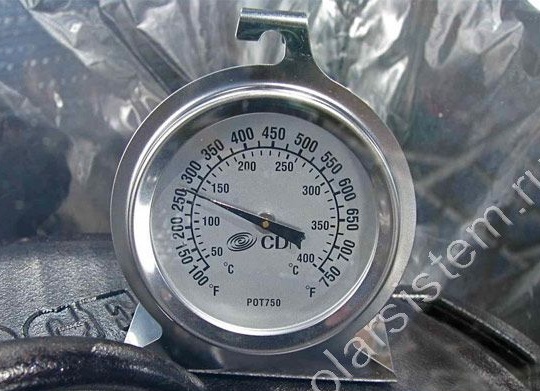
So, if you want to make sure of the possibilities of using solar energy for cooking, the author encourages you to use such a simple scheme of a solar furnace for an initial experience. In addition, this design can be gradually improved by simply adding reflectors and a better insulation.
